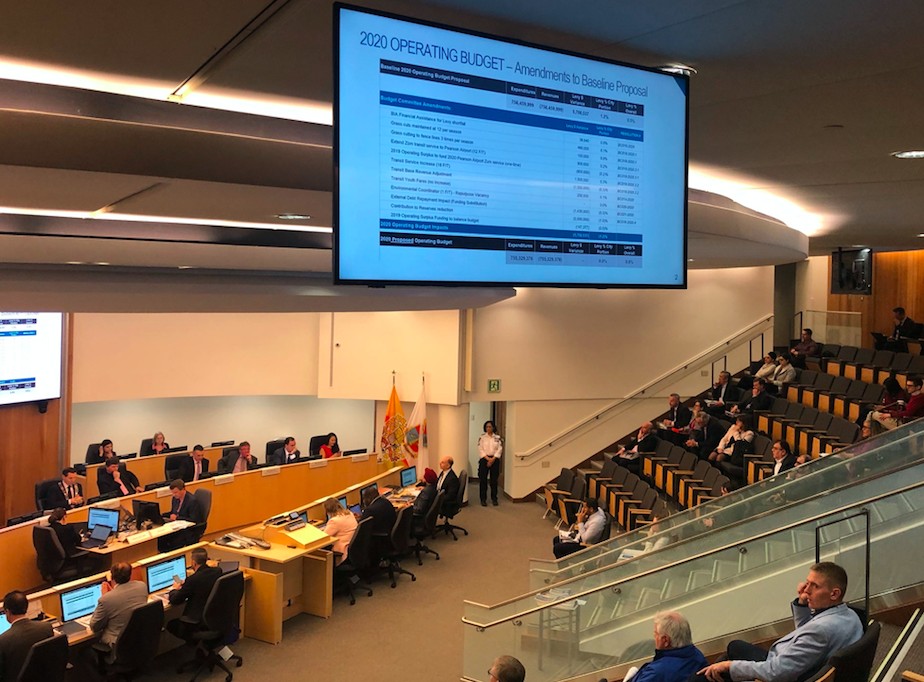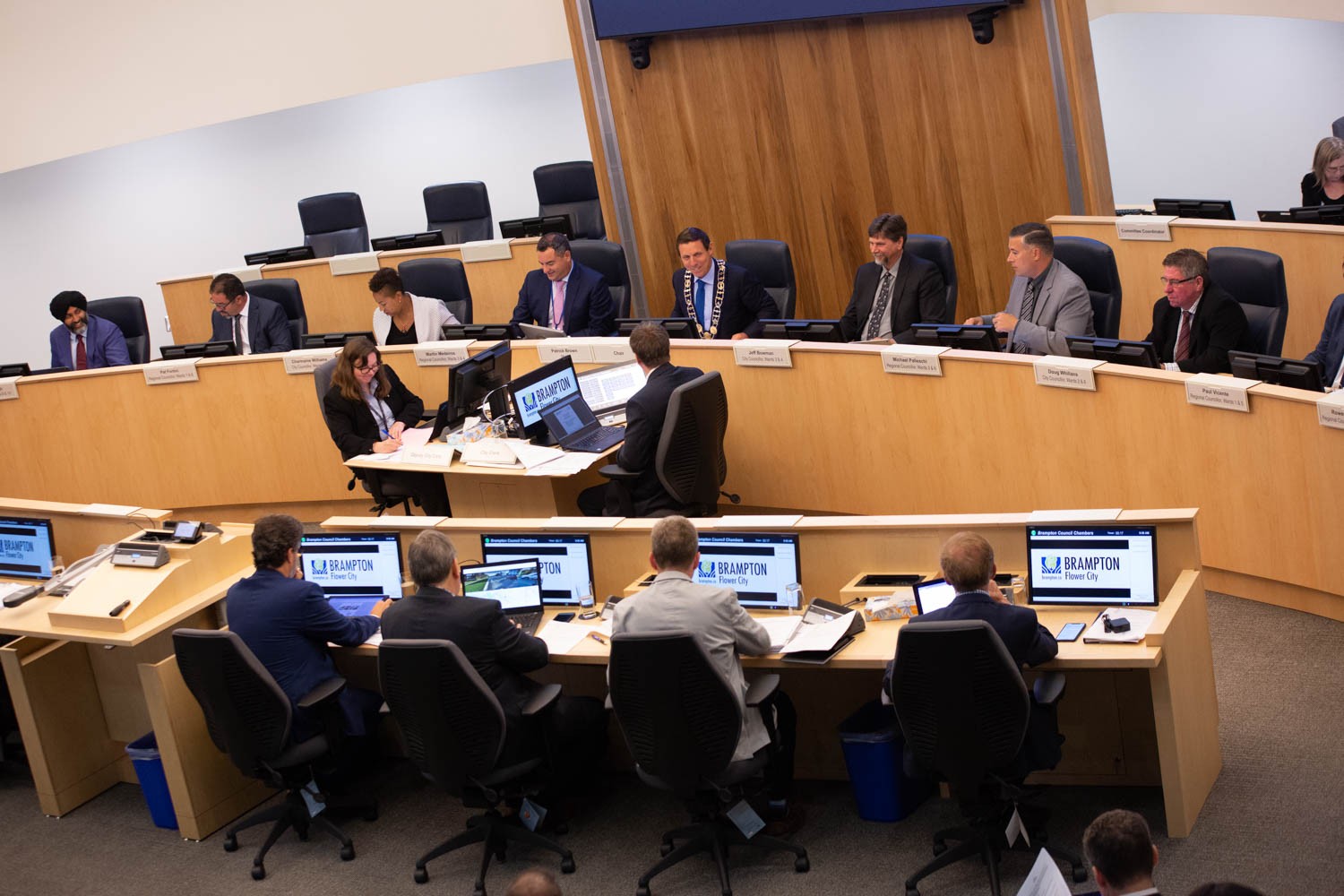
Brampton approves controversial tax freeze for 2020
A cheer erupted in council chambers as the city finalized a tax freeze for the second year in a row. But behind the excitement hides a host of problems.
On Wednesday night, the 2020 budget was approved for a total of $977 million (including $755 million for the operating budget and $222 million for the capital budget). It took a bit of financial wrangling, including a $5 million reduction to reserve contributions in order to make the freeze happen on the city’s portion of the bill, but from the outset it was clear Brown had no other agenda.
The cities of Mississauga and Oshawa and their former respective mayors Hazel McCallion and the late Nancy Diamond both prided themselves on continuous zero to minimal tax increases throughout their mayoral terms, decisions which resulted in neglected infrastructure and community projects down the road. In the short-term, these decisions were immensely popular for the two mayors, but future administrations were left with hard financial decisions and residents were stuck footing the bills of high property taxes to make up for lost time.
Mayor Patrick Brown doesn't believe future Bramptonians will be left in the same situation. “They didn't have a transit or infrastructure levy. We do. They weren’t making the contribution of this size to their reserves,” Brown told The Pointer.

Brampton City Council chambers
However, according to the city’s financial master plan, these continuous freezes raise a lot of questions about how Brampton plans to fund future projects. That document, approved in 2017, states the city will be able to manage its basic needs over the coming years with “modest” tax increases in the general range of 3 to 5 percent. And while Mayor Brown likes to point to his infrastructure levy as a key to protecting the city in the event revenue is needed for major repairs, this base scenario already includes said levy. It means, according to its own documents, the city could soon fall behind. In fact, taking into account the infrastructure levy, the plan does not include funding for major projects the city will need to pay for in the near future.
“The base scenario does not account for a number of potential major projects, such as Riverwalk and the future university, and assumes full senior government grant funding should the City move forward with construction of the Hurontario corridor LRT extension and/or the Queen Street LRT/BRT,” the document reads.
Further, while the city is placing a supposed record amount of funding into reserves, “the largest contribution in city history,” according to Brown, it’s clear that the 2020 contribution of $111 million could easily be used up in a single year. In fact, 2019 saw the city’s reserve accounts raided for more than $100 million.
It is not clear which reserves will be impacted by the $5 million reduction. This was not decided at the Feb. 26 meeting and staff will work to determine where the money will come from, city treasurer David Sutton told council. If and when these details will be made public is unknown.
Reserve funds from the initial 2020 budget proposal, which will see contributions made for the year reduced by $5 million
There were a number of last minute additions to the operating budget. The Brampton BIA was allocated $39,000 in financial assistance to help plug a gap in its budget as a result of lost revenue due to vacant buildings. Sutton also brought up $22,000 required by the BIA for rent relief, a motion not discussed before final budget deliberations on Feb. 26. While it’s not clear where this money will come from, it may be accounted for through additional charges the city will put towards license fees for adult entertainment establishments. This will increase the licensing fee of a body-rub parlor to $9,025 and the license fee for an operator to $923.
Responding to repeated calls from members of the public, councillors also reversed course on the proposed transit budget, which wouldn’t have added any new service hours in 2020. The city is now allocating $900,000 to extending Züm transit service to Toronto Pearson International Airport. This came after a presentation from the Greater Toronto Transit Authority on Feb. 19 that stated more than 10,000 Brampton residents are employed at Pearson, 13 percent of whom rely on transit to get to work. Extending the airport bus service will double the number of employees who have access to a one-transfer connection. The money will fund 12 full-time operators to complete the job, funding for which will come from the 2019 operating surplus — a one-time funding source.
Additionally, funding for 18 full-time operators has been added to the 2020 budget for Brampton Transit, after the initial budget proposal eliminated 81 planned positions. This will cost the city $1.5 million, which it plans on balancing through the additional transit revenue increased service will bring.
According to the presentation from Alex Milojevic, general manager of Brampton Transit, the 2020 budget is projecting $82.6 million from user fees and service charges. This revenue offsets $130.7 million in labour costs and $42.9 million of “other expenses” in the transit budget. The city will also find an additional $250,000 in the budget to eliminate the planned increase for youth transit fares. It was a motion pushed forward by Wards 7 and 8 Councillor Charmaine Williams, who advocated for fares to not be increased to make it easier for young people to access transit and get to school.
A final addition to the operating budget is the hiring of an environmental coordinator, a motion put forward by Wards 3 and 4 Councillor Jeff Bowman. It’s not clear how much this will cost, but staff will find money for the position by looking at repurposing vacancies.
“Staff [are] suggesting…repurposing an existing vacant position so there will be no impact to [the] budget on that,” Sutton said. While details on the post aren’t available, the position is based on the premise of coordinating the city’s environmental initiatives across various city departments.
Besides the $5 million reduction to reserve funds, savings on the city’s fire campus, and $147,000 taken from the 2019 operating surplus leads to the $5.7 million reduction on the 2020 operating budget, allowing Brown and council to freeze taxes, which, when taking into account the Region of Peel and provincial education portion, will result in $64 more on the average residential tax bill.
While the addition to the reserves fund may be the greatest in the city’s history, the same may not be true for the city’s capital program. The program is seeing 41 percent less than the initial 2020 projection of $431.5 million. The current capital budget is $222 million. Two big projects were moved from the 2020 budget to 2021, including the $175 million transit storage facility and $50 million for widening Williams Parkway. “There’s a lot of work required in advance of those facilities…so they have been moved out to 2021 so they make up a large substantial amount of the 2021 ask,” Sutton said during the Feb. 26 deliberations. The capital budget projection for 2021 currently sits at about $593 million, more than double the capital budget for 2020.
This may not be the answer some Brampton residents who support a tax increase were looking for. Evident through delegations, the increase in property taxes would put money towards bettering the city for its growing population. The city presents itself as a municipality that has it all; economic development initiatives, low taxes, and investments in infrastructure for the future, which seems like a far cry from reality. “You can’t grow [and] you can’t contract. [It] doesn't make any sense and it won’t work,” Terry Miller, former city councilor, told council during his delegation on Feb. 20.
Email: [email protected]
Twitter: @nida_zafar
Tel: 416-890-7643
Submit a correction about this story


